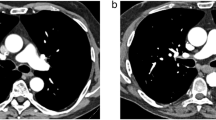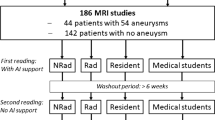Abstract
Objectives
To explore the use of 70-kVp tube voltage combined with high-strength deep learning image reconstruction (DLIR-H) in reducing radiation and contrast doses in coronary CT angiography (CCTA) in patients with body mass index (BMI) < 26 kg/m2, in comparison with the conventional scan protocol using 120 kVp and adaptive statistical iterative reconstruction (ASIR-V).
Methods
A total of 100 patients referred to CCTA were prospectively enrolled and randomly divided into two groups: low-dose group (n = 50) with 70 kVp, Smart mA for noise index (NI) of 36HU, contrast dose rate of 16mgI/kg/s, and DLIR-H, and conventional group (n = 50) with 120 kV, Smart mA for NI of 25HU, contrast dose rate of 32mgI/kg/s, and 60%ASIR-V. Radiation and contrast dose, subjective image quality score, and objective image quality measurement (image noise, contrast-noise-ratio (CNR), and signal–noise-ratio (SNR) for vessel) were compared between the two groups.
Results
Low-dose group used significantly reduced contrast dose (23.82 ± 3.69 mL, 50.6% reduction) and radiation dose (0.75 ± 0.14 mSv, 54.5% reduction) compared to the conventional group (48.23 ± 6.38 mL and 1.65 ± 0.66 mSv, respectively) (all p < 0.001). Both groups had similar enhancement in vessels. However, the low-dose group had lower background noise (23.57 ± 4.74 HU vs. 35.04 ± 8.41 HU), higher CNR in RCA (48.63 ± 10.76 vs. 29.32 ± 5.52), LAD (47.33 ± 10.20 vs. 29.27 ± 5.12), and LCX (46.74 ± 9.76 vs. 28.58 ± 5.12) (all p < 0.001) compared to the conventional group.
Conclusions
The use of 70-kVp tube voltage combined with DLIR-H for CCTA in normal size patients significantly reduces radiation dose and contrast dose while further improving image quality compared with the conventional 120-kVp tube voltage with 60%ASIR-V.
Key Points
• The combination of 70-kVp tube voltage and high-strength deep learning image reconstruction (DLIR-H) algorithm protocol reduces approximately 50% of radiation and contrast doses in coronary computed tomography angiography (CCTA) compared with the conventional scan protocol.
• CCTA of normal size (BMI < 26 kg/m2) patients acquired at sub-mSv radiation dose and 24 mL contrast dose through the combination of 70-kVp tube voltage and DLIR-H algorithm achieves excellent diagnostic image quality with a good inter-rater agreement.
• DLIR-H algorithm shows a higher capacity of significantly reducing image noise than adaptive statistical iterative reconstruction algorithm in CCTA examination.


Similar content being viewed by others
Abbreviations
- ASIR-V:
-
Volume-based adaptive statistical iterative reconstruction
- BMI:
-
Body mass index
- CAD:
-
Coronary heart disease
- CCS:
-
Chronic coronary syndrome
- CCTA:
-
Coronary computed tomography angiography
- CIN:
-
Contrast-induced nephropathy
- CNR:
-
Contrast-noise-ratio
- CPR:
-
Curved planar reformat
- CTDIvol:
-
Volumetric CT dose index
- DLIR:
-
Deep learning image reconstruction
- DLP:
-
Dose-length product
- DNN:
-
Deep neural networks
- ED:
-
Effective dose
- FBP:
-
Filtered back projection
- HR:
-
Heart rate
- IR:
-
Iterative reconstruction
- LAD:
-
Left anterior descending branch
- LCX:
-
Left circumflex
- MI:
-
Myocardial infarction
- MIP:
-
Maximum intensity projection
- NI:
-
Noise index
- RCA:
-
Right coronary artery
- ROI:
-
Region of interest
- SNR:
-
Signal–noise-ratio
- SSF:
-
Snapshot freeze
- VR:
-
Volume rendering
References
SCOT-HEART investigators (2015) CT coronary angiography in patients with suspected angina due to coronary heart disease (SCOT-HEART): an open-label, parallel-group, multicentre trial. Lancet 385(9985):2383–2391
Knuuti J, Wijns W, Saraste A et al (2019) 2019 ESC Guidelines for the diagnosis and management of chronic coronary syndromes. Eur Heart J 41(3):407–477
SCOT-HEART Investigators, Newby DE, Adamson PD et al (2018) Coronary CT angiography and 5-year risk of myocardial infarction. N Engl J Med 379(10):924–933
Kosmala A, Petritsch B, Weng AM, Bley TA, Gassenmaier T (2019) Radiation dose of coronary CT angiography with a third-generation dual-source CT in a “real-world” patient population. Eur Radiol 29(8):4341–4348
Troy M. LaBounty MD (2020) Reducing radiation dose in coronary computed tomography angiography: we are not there yet. JACC Cardiovasc Imaging 13(2Part1):435–436.
Formosa A, Santos DM, Marcuzzi D, Common AA, Prabhudesai V (2016) Low contrast dose catheter-directed CT angiography (CCTA). Cardiovasc Intervent Radiol 39(4):606–610
Leipsic JA, Achenbach S (2020) The ISCHEMIA trial: implication for cardiac imaging in 2020 and beyond. Radiol Cardiothorac Imaging 2(2):e200021. https://doi.org/10.1148/ryct.2020200021
Villines TC (2018) Coronary CTA should be the initial test in most patients with stable chest pain: PRO. American College of Cardiology 10:1–11
Yin WH, Lu B, Gao JB et al (2015) Effect of reduced x-ray tube voltage, low iodine concentration contrast medium, and sinogram-affirmed iterative reconstruction on image quality and radiation dose at coronary CT angiography: results of the prospective multicenter REALISE trial. J Cardiovasc Comput Tomogr 9(3):215–224
Chen Y, Liu Z, Li M et al (2019) Reducing both radiation and contrast doses in coronary CT angiography in lean patients on a 16-cm wide-detector CT using 70 kVp and ASiR-V algorithm, in comparison with the conventional 100-kVp protocol. Eur Radiol 29(6):3036–3043
Benz DC, Benetos G, Rampidis G et al (2020) Validation of deep-learning image reconstruction for coronary computed tomography angiography: impact on noise, image quality and diagnostic accuracy. J Cardiovasc Comput Tomogr 14(5):444–451
Hsieh J, Liu E, Nett B, Tang J, Thibault J, Sahney S (2019) A new era of image reconstruction: TrueFidelityTM Technical white paper on deep learning image reconstruction. Whitepaper, Online version. https://www.gehealthcare.com/-/jssmedia/040dd213fa89463287155151fdb01922.pdf
Andreini D, Pontone G, Mushtaq S et al (2018) Image quality and radiation dose of coronary CT angiography performed with whole-heart coverage CT scanner with intra-cycle motion correction algorithm in patients with atrial fibrillation. Eur Radiol 28(4):1383–1392
Feng RQ, Tong JJ, Liu XF, Zhao Y, Zhang L (2017) High-pitch coronary CT angiography at 70 kVp adopting a protocol of low injection speed and low volume of contrast medium. Korean J Radiol 18(5):763–772. https://doi.org/10.3348/kjr.2017.18.5.763
Zhang LJ, Qi L, Wang J et al (2014) Feasibility of prospectively ECG-triggered high-pitch coronary CT angiography with 30 mL iodinated contrast agent at 70 kVp: Initial experience. Eur Radiol 24(7):1537–1546
Formentini FS, Zaina Nagano FE, Lopes Neto FDN, Adam EL, Fortes FS, Silva LFD (2019) Coronary artery disease and body mass index: what is the relationship? Clin Nutr ESPEN 34:87–93. https://doi.org/10.1016/j.clnesp.2019.08.008
Labounty TM, Gomez MJ, Achenbach S et al (2013) Body mass index and the prevalence, severity, and risk of coronary artery disease: an international multicentre study of 13 874 patients. Eur Heart J Cardiovasc Imaging 14(5):456–463
Achenbach S (2017) Coronary CT angiography-future directions. Cardiovasc Diagn Ther 7(5):432–438
Collet C, Onuma Y, Andreini D et al (2018) Coronary computed tomography angiography for heart team decision-making in multivessel coronary artery disease. Eur Heart J 39(42):3689–3698
Archbold RA (2016) Comparison between National Institute for Health and Care Excellence ( NICE ) and European Society of Cardiology ( ESC ) guidelines for the diagnosis and management of stable angina : implications for clinical practice. Open Heart 3(1):e000406. https://doi.org/10.1136/openhrt-2016-000406
Mettler FA, Bhargavan M, Faulkner K et al (2009) Radiologic and nuclear medicine studies in the United States and worldwide: frequency, radiation dose, and comparison with other radiation sources - 1950–2007. Radiology 253(2):520–531
Geyer LL, Schoepf UJ, Meinel FG et al (2015) State of the art: iterative CT reconstruction techniques. Radiology 276(2):338–356
Den Harder AM, Willemink MJ, De Ruiter QMB et al (2015) Achievable dose reduction using iterative reconstruction for chest computed tomography: a systematic review. Eur J Radiol 84(11):2307–2313
Stocker TJ, Leipsic J, Hadamitzky M et al (2020) Application of low tube potentials in CCTA: results from the pROTECTION VI study. JACC Cardiovasc Imaging 13(No.2Part1):425–434.
Pauchard B, Higashigaito K, Lamri-Senouci A et al (2017) Iterative reconstructions in reduced-dose CT: which type ensures diagnostic image quality in young oncology patients? Acad Radiol 24(9):1114–1124
Mileto A, Guimaraes LS, McColloughet CH, Fletcher JG, Yu L (2019) State of the art in abdominal CT : the limits of iterative. Radiology 293(3):491–503
Lell MM, Kachelrieß M (2020) Recent and upcoming technological developments in computed tomography: high speed, low dose, deep learning, multienergy. Invest Radiol 55(1):8–19
McBee MP, Awan OA, Colucci AT et al (2018) Deep learning in radiology. Acad Radiol 25(11):1472–1480. https://doi.org/10.1016/j.acra.2018.02.018
Akagi M, Nakamura Y, Higaki T et al (2019) Deep learning reconstruction improves image quality of abdominal ultra-high-resolution CT. Eur Radiol 29(11):6163–6171
Faucon AL, Bobrie G, Clément O (2019) Nephrotoxicity of iodinated contrast media: From pathophysiology to prevention strategies. Eur J Radiol 116:231–241. https://doi.org/10.1016/j.ejrad.2019.03.008
Kok M, Mihl C, Hendriks BMF et al (2016) Optimizing contrast media application in coronary CT angiography at lower tube voltage: evaluation in a circulation phantom and sixty patients. Eur J Radiol 85(8):1068–1074
Luo S, Zhang LJ, Meinel FG et al (2014) Low tube voltage and low contrast material volume cerebral CT angiography. Eur Radiol 24(7):1677–1685
Tan SK, Yeong CH, Aman RRAR et al (2018) Low tube voltage prospectively ECG-triggered coronary CT angiography: a systematic review of image quality and radiation dose. Br J Radiol 91(No.1088):20170874.
Canstein C, Korporaal JG (2017) Reduction of contrast agent dose at low kV settings. White Paper. https://www.ct-meeting.org/data/White_Paper_Contrast_Agent_Dose_HOOD05162002623107_150268118.pdf
Funding
The trial is funded by the Science and Technology Program of Sichuan (grant number: 2019YFS0522) and the 1.3.5 project for disciplines of excellence-Clinical Research Incubation Project, West China Hospital Sichuan University (grant number: ZYGD18019 and 2021HXFH021).
Author information
Authors and Affiliations
Corresponding authors
Ethics declarations
Guarantor
The scientific guarantor of this publication is Zhenlin Li and Yong He.
Conflict of interest
The authors of this manuscript declare no relationships with any companies whose products or services may be related to the subject matter of the article.
Statistics and biometry
No complex statistical methods were necessary for this paper.
Informed consent
Written informed consent was obtained from all subjects (patients) in this study.
Ethical approval
Institutional Review Board approval was obtained.
Methodology
• prospective
• randomised controlled trial
• performed at one institution
Additional information
Publisher's note
Springer Nature remains neutral with regard to jurisdictional claims in published maps and institutional affiliations.
Yong He and Zhenlin Li co-supervised this work.
Supplementary Information
Below is the link to the electronic supplementary material.
Rights and permissions
About this article
Cite this article
Li, W., Diao, K., Wen, Y. et al. High-strength deep learning image reconstruction in coronary CT angiography at 70-kVp tube voltage significantly improves image quality and reduces both radiation and contrast doses. Eur Radiol 32, 2912–2920 (2022). https://doi.org/10.1007/s00330-021-08424-5
Received:
Revised:
Accepted:
Published:
Issue Date:
DOI: https://doi.org/10.1007/s00330-021-08424-5




